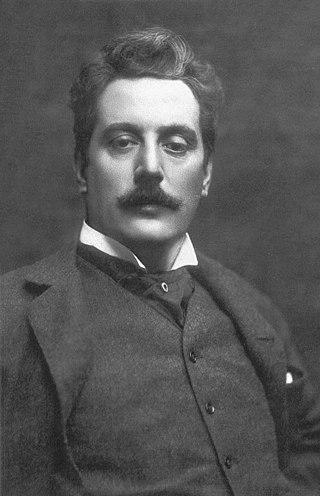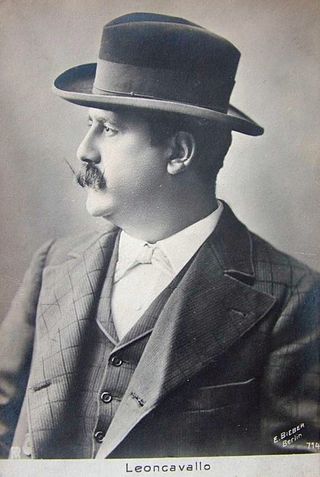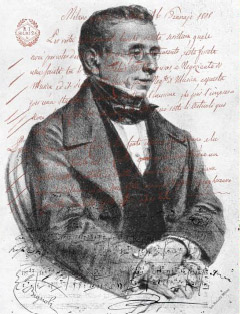Related Research Articles

Giacomo Puccini was an Italian composer known primarily for his operas. Regarded as the greatest and most successful proponent of Italian opera after Verdi, he was descended from a long line of composers, stemming from the late-Baroque era. Though his early work was firmly rooted in traditional late-19th-century Romantic Italian opera, he later developed his work in the realistic verismo style, of which he became one of the leading exponents.

Giuseppe Fortunino Francesco Verdi was an Italian composer best known for his operas. He was born near Busseto, a small town in the province of Parma, to a family of moderate means, receiving a musical education with the help of a local patron, Antonio Barezzi. Verdi came to dominate the Italian opera scene after the era of Gioachino Rossini, Vincenzo Bellini, and Gaetano Donizetti, whose works significantly influenced him.

La traviata is an opera in three acts by Giuseppe Verdi set to an Italian libretto by Francesco Maria Piave. It is based on La Dame aux camélias (1852), a play by Alexandre Dumas fils, which he adapted from his own 1848 novel. The opera was originally titled Violetta, after the main character. It was first performed on 6 March 1853 at La Fenice opera house in Venice.

Ruggero Leoncavallo was an Italian opera composer and librettist. Although he produced numerous operas and songs throughout his career it is his opera Pagliacci (1892) that remained his lasting contribution, despite attempts to escape the shadow of his greatest success.

Tosca is an opera in three acts by Giacomo Puccini to an Italian libretto by Luigi Illica and Giuseppe Giacosa. It premiered at the Teatro Costanzi in Rome on 14 January 1900. The work, based on Victorien Sardou's 1887 French-language dramatic play, La Tosca, is a melodramatic piece set in Rome in June 1800, with the Kingdom of Naples's control of Rome threatened by Napoleon's invasion of Italy. It contains depictions of torture, murder, and suicide, as well as some of Puccini's best-known lyrical arias.

A libretto is the text used in, or intended for, an extended musical work such as an opera, operetta, masque, oratorio, cantata or musical. The term libretto is also sometimes used to refer to the text of major liturgical works, such as the Mass, requiem and sacred cantata, or the story line of a ballet.

In opera, verismo, from vero, meaning 'true', was a post-Romantic operatic tradition associated with Italian composers such as Pietro Mascagni, Ruggero Leoncavallo, Umberto Giordano, Francesco Cilea and Giacomo Puccini.

Francesco Maria Piave was an Italian opera librettist who was born in Murano in the lagoon of Venice, during the brief Napoleonic Kingdom of Italy.

Clelia Maria Giuseppa (Giuseppina) Strepponi was a nineteenth-century Italian operatic soprano of great renown and the second wife of composer Giuseppe Verdi.

Gianni Schicchi is a comic opera in one act by Giacomo Puccini to an Italian libretto by Giovacchino Forzano, composed in 1917–18. The libretto is based on an incident mentioned in Dante's Divine Comedy. The work is the third and final part of Puccini's Il trittico – three one-act operas with contrasting themes, originally written to be presented together. Although it continues to be performed with one or both of the other trittico operas, Gianni Schicchi is now more frequently staged either alone or with short operas by other composers. The aria "O mio babbino caro" is one of Puccini's best known, and one of the most popular arias in opera.

Casa Ricordi is a publisher of primarily classical music and opera. Its classical repertoire represents one of the important sources in the world through its publishing of the work of the major 19th-century Italian composers such as Gioachino Rossini, Gaetano Donizetti, Vincenzo Bellini, Giuseppe Verdi, and, later in the century, Giacomo Puccini, composers with whom one or another of the Ricordi family came into close contact.

Monsignor Lorenzo Perosi was an Italian composer of sacred music and the only member of the Giovane Scuola who did not write opera. In the late 1890s, while he was still only in his twenties, Perosi was an internationally celebrated composer of sacred music, especially large-scale oratorios. Nobel Prize winner Romain Rolland wrote, "It's not easy to give you an exact idea of how popular Lorenzo Perosi is in his native country." Perosi's fame was not restricted to Europe. A 19 March 1899 New York Times article entitled "The Genius of Don Perosi" began, "The great and ever-increasing success which has greeted the four new oratorios of Don Lorenzo Perosi has placed this young priest-composer on a pedestal of fame which can only be compared with that which has been accorded of late years to the idolized Pietro Mascagni by his fellow-countrymen." Gianandrea Gavazzeni made the same comparison: "The sudden clamors of applause, at the end of the [19th] century, were just like those a decade earlier for Mascagni." Perosi worked for five Popes, including Pope Pius X who greatly fostered his rise.

Lorenzo Ferrero is an Italian composer, librettist, author, and book editor. He started composing at an early age and has written over a hundred compositions thus far, including twelve operas, three ballets, and numerous orchestral, chamber music, solo instrumental, and vocal works. His musical idiom is characterized by eclecticism, stylistic versatility, and a neo-tonal language.

Jérusalem is a grand opera in four acts by Giuseppe Verdi. The libretto was to be an adaptation and partial translation of the composer's original 1843 Italian opera, I Lombardi alla prima crociata. It was the one opera which he regarded as the most suitable for being translated into French and, taking Eugène Scribe's advice, Verdi agreed that a French libretto was to be prepared by Alphonse Royer and Gustave Vaëz, who had written the libretto for Donizetti's most successful French opera, La favorite. The opera received its premiere performance at the Salle Le Peletier in Paris on 26 November 1847. The maiden production was designed by Paul Lormier (costumes), Charles Séchan, Jules Diéterle and Édouard Desplechin, and Charles-Antoine Cambon and Joseph Thierry.
Franco Vittadini was an Italian composer and conductor. As a composer he is mostly known for his operas and sacred music.

Mosco Carner was an Austrian-born British musicologist, conductor and critic. He wrote on a wide range of music subjects, but was particularly known for his studies on the life and works of the composers Giacomo Puccini and Alban Berg.
Evangelista Gennaro Gorga was an Italian lyric tenor. He is best known for originating the role of Rodolfo in the original production of Giacomo Puccini's La bohème at the Teatro Regio Torino in 1896.

Fanny Salvini-Donatelli was an Italian operatic soprano. She is best known today for creating the role of Violetta in Verdi's opera, La traviata, but she was also an admired interpreter of the composer's other works as well as those by Donizetti.

Teresa Saporiti was an Italian operatic soprano and composer most remembered today for creating the role of Donna Anna in Mozart's opera Don Giovanni. She was born in Milan and died there at the age of 106. In her later years, she was often referred to by her married name, Teresa Saporiti-Codecasa.
Mary Jane Phillips-Matz was an American biographer and writer on opera. She is mainly known for her biography of Giuseppe Verdi, a result of 30 years' research and published in 1992 by Oxford University Press. Born in Lebanon, Ohio and educated at Smith College and Columbia University, she lived for many years in Italy, and even after her return to the United States in the early 1970s spent her summers in Verdi's hometown of Busseto where she continued her exhaustive research into his life. She died in New York City at the age of 86
References
- Budden, Julian (2002) Puccini: His Life and Works, Oxford University Press. ISBN 0-19-517974-9
- Ciampa, Leonardo (2006). Don Lorenzo Perosi. ISBN 1-4259-3440-4
- Fanelli, Jean Grundy (2004) "Realism and the Giovane Scuola", Opera for Everyone: A Historic, Social, Artistic, Literary, and Musical Study, Scarecrow Press. ISBN 0-8108-4894-5
- Phillips-Matz, Mary Jane, "Friends and Rivals", Opera News , January 2000. Accessed via subscription 20 October 2008.
- Sadie, Stanley (ed.) (1992) The New Grove Dictionary of Opera , Vol. 2. Macmillan. ISBN 0-935859-92-6